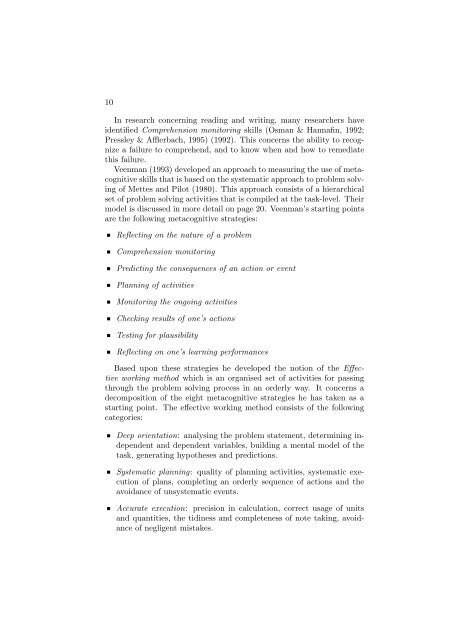The role of metacognitive skills in learning to solve problems
The role of metacognitive skills in learning to solve problems
The role of metacognitive skills in learning to solve problems
You also want an ePaper? Increase the reach of your titles
YUMPU automatically turns print PDFs into web optimized ePapers that Google loves.
10<br />
In research concern<strong>in</strong>g read<strong>in</strong>g and writ<strong>in</strong>g, many researchers have<br />
identified Comprehension moni<strong>to</strong>r<strong>in</strong>g <strong>skills</strong> (Osman & Hannaf<strong>in</strong>, 1992;<br />
Pressley & Afflerbach, 1995) (1992). This concerns the ability <strong>to</strong> recognize<br />
a failure <strong>to</strong> comprehend, and <strong>to</strong> know when and how <strong>to</strong> remediate<br />
this failure.<br />
Veenman (1993) developed an approach <strong>to</strong> measur<strong>in</strong>g the use <strong>of</strong> <strong>metacognitive</strong><br />
<strong>skills</strong> that is based on the systematic approach <strong>to</strong> problem solv<strong>in</strong>g<br />
<strong>of</strong> Mettes and Pilot (1980). This approach consists <strong>of</strong> a hierarchical<br />
set <strong>of</strong> problem solv<strong>in</strong>g activities that is compiled at the task-level. <strong>The</strong>ir<br />
model is discussed <strong>in</strong> more detail on page 20. Veenman’s start<strong>in</strong>g po<strong>in</strong>ts<br />
are the follow<strong>in</strong>g <strong>metacognitive</strong> strategies:<br />
Reflect<strong>in</strong>g on the nature <strong>of</strong> a problem<br />
Comprehension moni<strong>to</strong>r<strong>in</strong>g<br />
Predict<strong>in</strong>g the consequences <strong>of</strong> an action or event<br />
Plann<strong>in</strong>g <strong>of</strong> activities<br />
Moni<strong>to</strong>r<strong>in</strong>g the ongo<strong>in</strong>g activities<br />
Check<strong>in</strong>g results <strong>of</strong> one’s actions<br />
Test<strong>in</strong>g for plausibility<br />
Reflect<strong>in</strong>g on one’s learn<strong>in</strong>g performances<br />
Based upon these strategies he developed the notion <strong>of</strong> the Effective<br />
work<strong>in</strong>g method which is an organised set <strong>of</strong> activities for pass<strong>in</strong>g<br />
through the problem solv<strong>in</strong>g process <strong>in</strong> an orderly way. It concerns a<br />
decomposition <strong>of</strong> the eight <strong>metacognitive</strong> strategies he has taken as a<br />
start<strong>in</strong>g po<strong>in</strong>t. <strong>The</strong> effective work<strong>in</strong>g method consists <strong>of</strong> the follow<strong>in</strong>g<br />
categories:<br />
Deep orientation: analys<strong>in</strong>g the problem statement, determ<strong>in</strong><strong>in</strong>g <strong>in</strong>dependent<br />
and dependent variables, build<strong>in</strong>g a mental model <strong>of</strong> the<br />
task, generat<strong>in</strong>g hypotheses and predictions.<br />
Systematic plann<strong>in</strong>g: quality <strong>of</strong> plann<strong>in</strong>g activities, systematic execution<br />
<strong>of</strong> plans, complet<strong>in</strong>g an orderly sequence <strong>of</strong> actions and the<br />
avoidance <strong>of</strong> unsystematic events.<br />
Accurate execution: precision <strong>in</strong> calculation, correct usage <strong>of</strong> units<br />
and quantities, the tid<strong>in</strong>ess and completeness <strong>of</strong> note tak<strong>in</strong>g, avoidance<br />
<strong>of</strong> negligent mistakes.
















